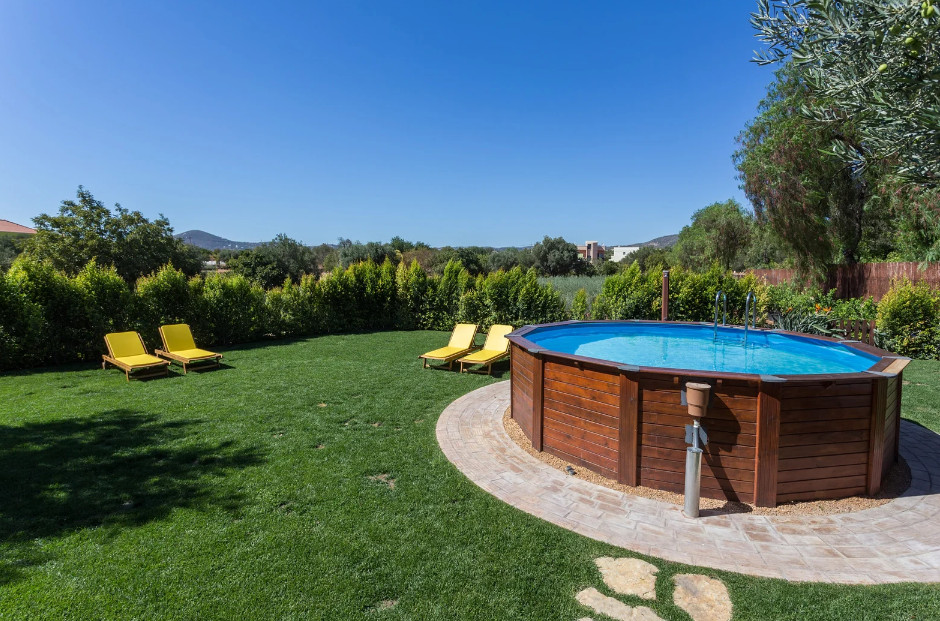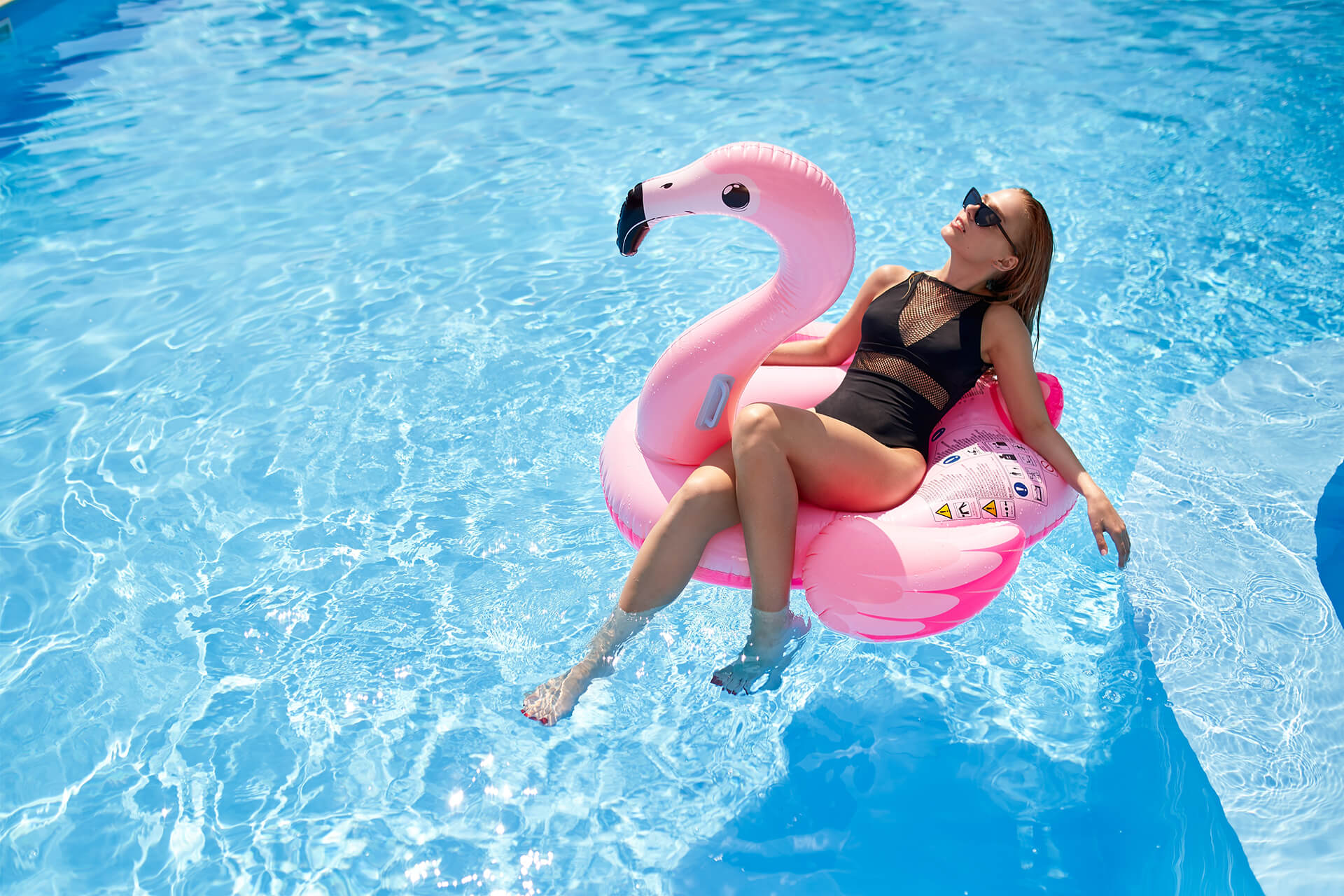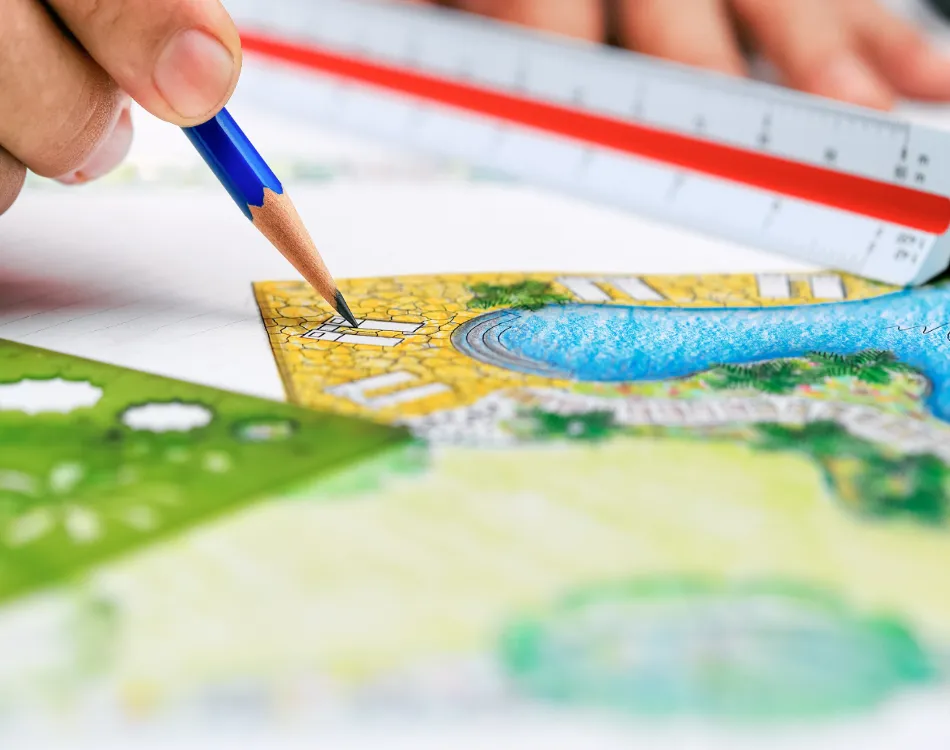
A pool is a significant investment, so you want to ensure you get it right first. The good news is that with careful planning, you can design a swimming pool that will perfectly suit your needs and complement your landscape.
At its core, designing a pool is about determining how you want to use and enjoy your space. Knowing how to design a pool involves considering factors such as the type of pool you want (e.g., concrete or fiberglass), the desired features and amenities (e.g., tanning ledges or deck jets), and the pool’s size, shape, and depth. Remember how it will be integrated into your overall outdoor space design.
Other considerations may include landscaping and privacy, choosing materials for the coping and surrounding surfaces, securing construction permits, and addressing any property restrictions.
Keep reading to learn our top 10 tips for designing a pool that you and your family will love!
How To Design A Pool
1. How Do You Want To Use Your Pool?

Our first tip is to think about how you want to use your swimming pool. Do you envision yourself relaxing in a serene oasis? Or do you see yourself hosting pool parties for all your friends?
The way you plan on using your pool will dictate its size, shape, and features. For example, if you plan on using your pool for exercise, you’ll want to make sure it’s large enough to accommodate lap swimming.
On the other hand, if you just want a place to cool off on a hot day, a small plunge pool might be more your style.
Don’t rush this step in how to design a pool! Determining exactly how you want to use your pool is the starting point for any great swimming pool design. If you are still unsure about how you want to use your pool, take some time to note what you most enjoy about going to pools. Then bring those notes to reputable swimming pool companies who can help point you in the right direction.
2. Decide What Type Of Pool You Want
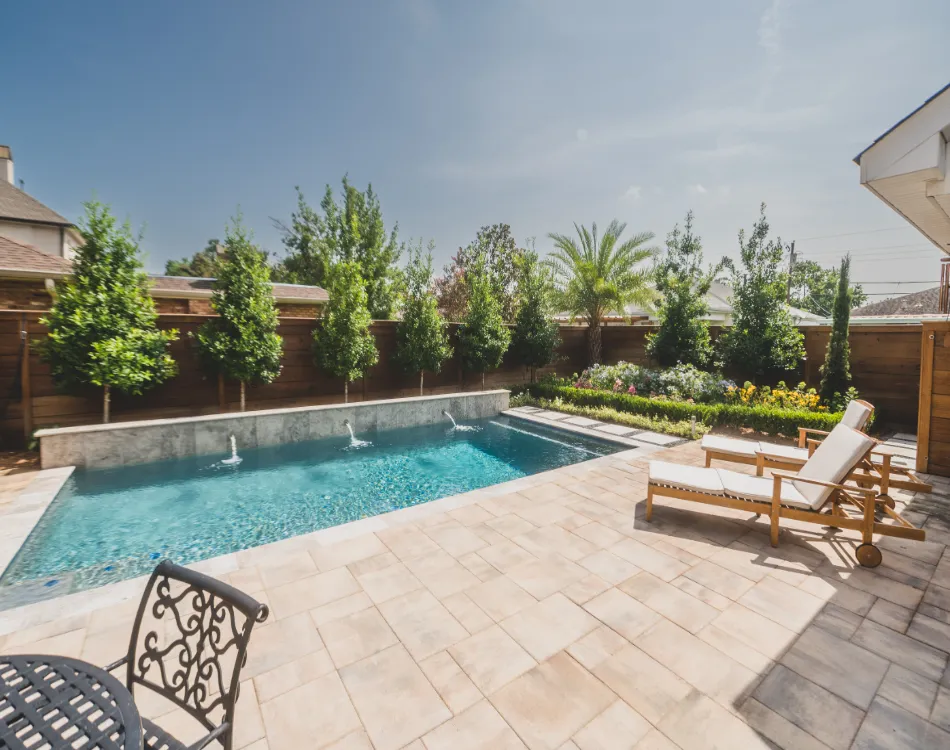
After you’ve determined how you want to use your swimming pool, it’s time to start thinking about what type of pool will best fit your needs. When it comes to pools, there are 3 most common types people consider in the how to design a pool phase: concrete, fiberglass, and vinyl.
Here’s a brief overview of the pros and cons of each pool type:
Concrete Pool
Pros: Concrete pools are the most popular type of pool, and for good reasons. They’re durable, customizable, and built to last. So it’s probably no surprise that we at Miller Outdoors specialize in concrete pools!
Specifically, we use gunite concrete, an extremely strong and durable type of concrete. Gunite is easily customizable to any shape. It’s also less prone to cracking than other types of concrete, making it an ideal material for building pools.
Cons: Concrete is strong and durable, but it is also the most expensive type of pool. If you’re on a budget, a fiberglass or vinyl pool may be a better option for you to consider in the how to design a pool process.
Fiberglass Pool
Pros: Fiberglass swimming pools are made from, you guessed it, fiberglass. They’re strong and durable, and they’re typically less expensive than concrete swimming pools. The biggest advantage of fiberglass pools is that they require very little upkeep. Their Gel Coat finish is non-porous, so it resists staining and fading.
Cons: Fiberglass pools don’t offer the same customization options as concrete pools. Since fiberglass pools are pre-fabricated in a factory, they have size and depth limitations due to road restrictions for delivery. This doesn’t stop people from considering them when thinking about how to design a pool.
Vinyl Pool
Pros: Vinyl swimming pools are the least expensive type of pool. So if you’re on a budget and you’re looking for a temporary pool solution, a vinyl pool may be just what you need. Vinyl liner swimming pools also have a wide range of design options and can be customized to any shape or size. The liner itself is available in a variety of colors and patterns.
Cons: Vinyl pools cost less, but they’re also the least durable. If you live in an area with extreme weather conditions (hot summers and cold winters), a vinyl swimming pool may not be the best choice for you. The lifespan of vinyl liners varies depending on the manufacturer and the amount of wear and tear. They typically need to be replaced at least once every 10 years, which is important to consider when thinking about how to design a pool.
Now we can move to the next tip for how to design a pool.
3. What Pool Features Do You Want To Include?
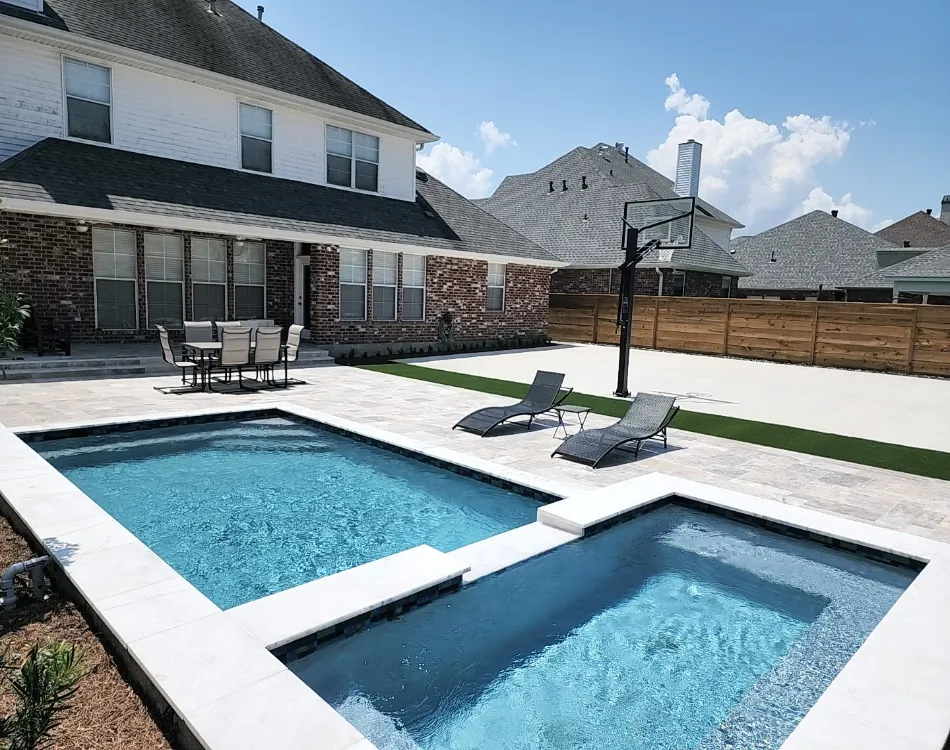
Now that you’ve determined how you are going to use your swimming pool and what type of pool you want, it’s time to consider features.
Do you want a heated swimming pool? A waterfall or other water feature?
There are endless possibilities when it comes to customizing your pool, so it’s important to think about what you really want and need before making any decisions. There is a lot of thinking involved regarding designing a pool.
Some of the most popular pool features in the New Orleans area that we have installed include:
- Spillover spas
- Tanning decks
- Bubblers
- LED lighting
- Deck jets
- Infinity edge pool
Remember that pool features can also include things in the pool area, such as fire bowls or pergolas.
A good strategy is to make a list of your desired swimming pool features and prioritize them from most important to least. A prioritized list will help you more easily decide which features are most important to you and which features you’d be willing to drop off your list if you run into budget constraints or other issues.
4. Guidelines For How To Design A Pool For Your Space
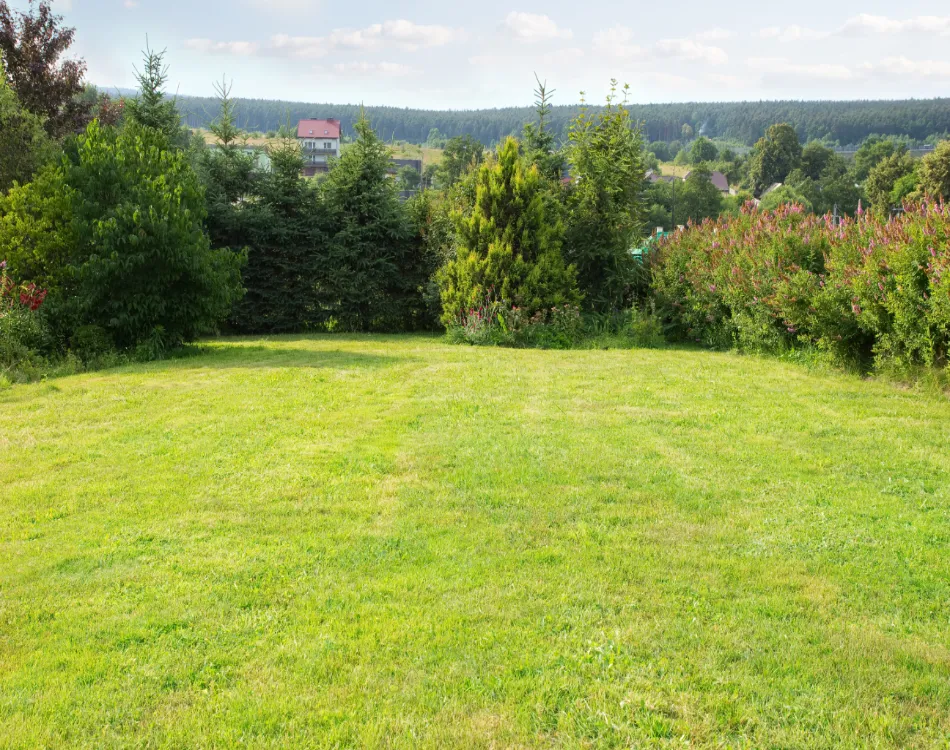
How to Design a Pool: A Complete Guide to Pool Planning
When planning how to design a pool, smart integration with your existing space is crucial. Your pool should feel like a natural extension of your home. Let’s explore the key factors that will shape your perfect pool design.
The size and shape of your property will determine your pool’s dimensions. But there are other important elements to consider beyond these basics. A well-designed pool enhances both functionality and aesthetic appeal.
Essential Guidelines for How to Design a Pool
Here are the key points to keep in mind:
- The entrance to your pool area should flow naturally from your home’s exit points. Consider where you’ll place the fence gate and shower facilities for maximum convenience and safety.
- Think about your swimming habits and preferred activities. This will help determine features like deep-end placement, lounging areas, and additional amenities like built-in seating.
- Work with your yard’s natural layout instead of against it. Unique property angles can inspire creative and distinctive pool designs that maximize available space.
- Proper drainage systems are vital, especially in areas like New Orleans that sit below sea level. Large channel drains with correct angles are essential for long-term maintenance.
Smart Pool Design Elements for Your Space
How to design a pool requires careful thought about traffic flow and usage patterns. Miller Outdoors emphasizes installing adequate drainage systems. They use larger channel drains rather than minimal 1-inch versions to ensure proper water management.
A successful pool design matches your lifestyle needs while enhancing your property value. Consider these practical aspects:
- Pool fence placement should provide security without disrupting the visual flow of your outdoor space
- Shower facilities and changing areas need convenient access points from both the pool and house
- Lounging spaces should complement the pool’s shape and size while offering both sun and shade options
Advanced Planning Tips for Pool Design
Learning how to design a pool means understanding the relationship between different outdoor elements. Start by mapping out these key areas:
- Traffic patterns from your home to the pool
- Sun exposure throughout the day
- Views from inside your house
- Storage areas for pool equipment and accessories
- Landscaping zones that complement your pool
Every backyard deserves a unique pool design that fits its specific characteristics. The best designs consider both immediate needs and future possibilities. Pool features should blend seamlessly with existing structures while offering practical functionality.
Remember that proper drainage, as emphasized by Miller Outdoors, plays a crucial role in long-term pool maintenance. Their expertise in installing larger channel drains demonstrates the importance of working with experienced professionals.
By following these guidelines and working with qualified contractors, you’ll create an outdoor oasis that perfectly suits your space and lifestyle. Your pool should not only look beautiful but also provide years of enjoyment with minimal maintenance concerns.
5. How To Choose The Right Pool Size, Shape, And Depth
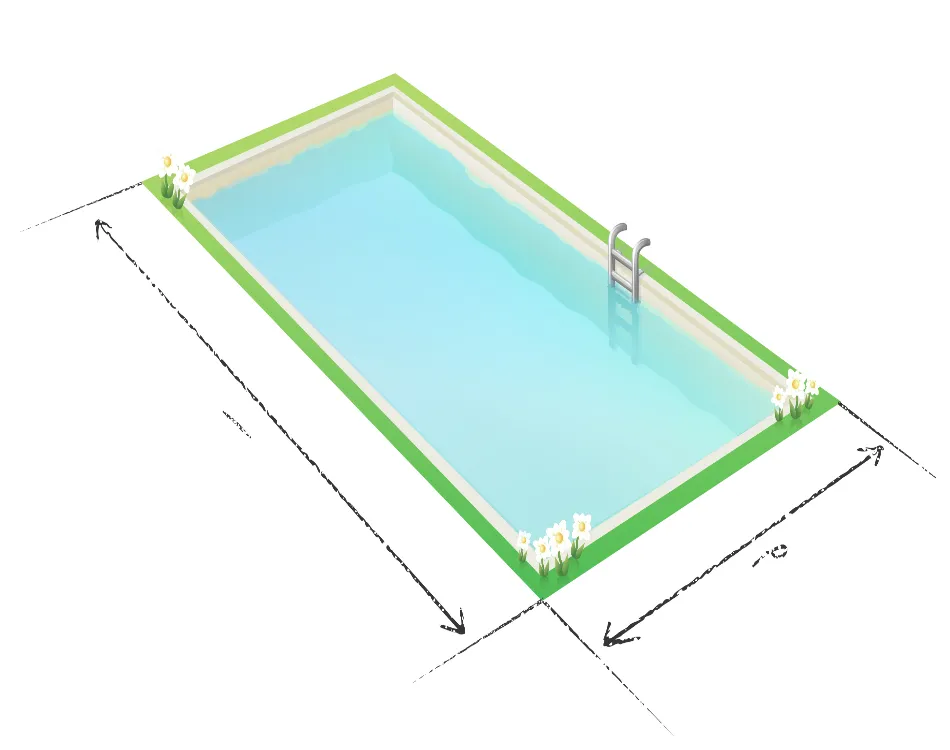
Choosing the right size, shape, and depth for your swimming pool is essential for how to design a pool. By taking into account the size of your yard and how you plan to use the pool, you can narrow down your options to find the perfect fit.
Size: In terms of size, it is important to leave enough space around the swimming pool for walking and safety. Otherwise, the most important considerations will be the size of your property and your personal size preference.
Shape: The shape of your pool will also play a role in its overall look and feel. You can choose from many different shapes. Rectangular pools are classic and elegant, while freeform pools can create a more naturalistic look. In our experience, rectangular pools are by far the most popular pool shape in the New Orleans area!
Depth: The depth of your swimming pool is another important consideration for how to design a pool. For example, if you are looking for somewhere to do laps, you will need at least five feet of water depth so that you can swim comfortably. Ultimately, the depth of your pool should be based on how you plan to use it most often.
By taking into account size, shape, and depth, you can narrow down your options and find the perfect pool for your home.
6. Choose The Materials For Your Pool Coping And Surrounding Surfaces
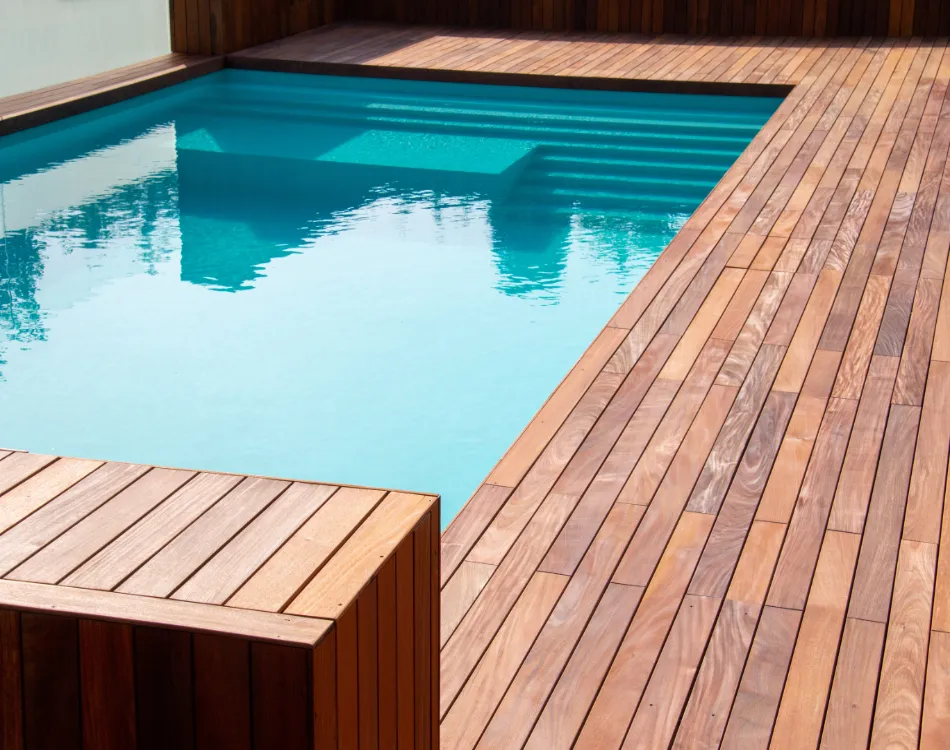
In order to create a complete and harmonious poolscape, you’ll need to choose the right materials for your pool edge (coping) and surrounding surfaces.
When contemplating how to design a pool, some common material choices to explore include concrete, stone, brick, tile, and wood.
If you live in a sunny climate, such as we have in Louisiana, you may want to consider travertine. This natural stone material is popular in the New Orleans area because it feels cooler to the touch than many other materials, even in hot weather!
Each material has a different feel and appearance. This makes it important to choose one that will complement the overall design of your pool. With so many options on the market, that can be a daunting task. But don’t worry–we’re here to help!
Read on for our top tips on how to design a pool when it comes to selecting the perfect coping and hardscape materials:
Overall design: The first thing you’ll need to consider is the overall design of your pool. Are you going for a sleek and modern pool look or something more traditional like a lap pool? This will help narrow down your choices of material.
For example, if you want a modern swimming pool, then concrete or stone would be a good choice for the coping. If you’re aiming for a more traditional look, then brick or flagstone would be better suited.
Functionality: Once you’ve decided on the overall style of your pool, the next part of how to design a pool is to think about functionality. How will the pool be used?
If it’s primarily for swimming, then you’ll want materials that are non-slip and easy to clean. If it’s more for relaxing and enjoying the view, then you might be more flexible with your choices.
Maintenance and durability: Take into account maintenance and durability when making your decision. Some materials will require more upkeep than others. For example, wood is porous and requires regular sealing.
With these how to design a pool factors in mind, you should have no trouble narrowing down your choices and selecting the perfect materials for your swimming pool coping and surrounding surfaces.
7. Landscaping And Privacy
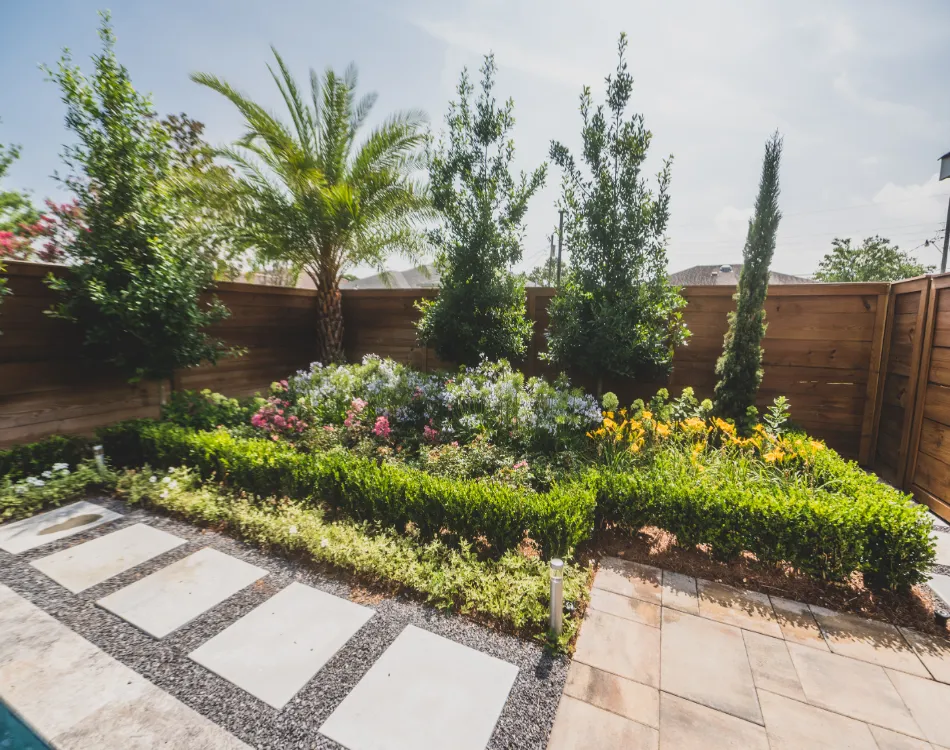
When it comes to landscaping and privacy around your swimming pool, there are many factors to consider:
- How large is your lot?
- How close are your neighbors?
- How much sun or shade does your pool get?
These are just a few of the questions you’ll need to answer before you can start planning your poolscape.
Privacy: If you’re looking to add privacy as part of your how to design a pool process, consider plants that are tall and dense. Evergreen trees and shrubs are a great choice, as they provide year-round privacy. If you have a small lot, however, you may want to avoid large plants that will take up too much space. Instead, opt for smaller shrubs or even potted plants that can be moved around as needed.
Landscaping: For landscaping around your backyard pool, it’s important to choose plants that are both beautiful and practical. If you don’t have a green thumb, you’ll want to choose low-maintenance plants that won’t require a lot of upkeep. If you have young children or pets, you’ll want to choose plants that are safe (i.e., non-toxic) and not likely to cause injuries.
We’re more than just experts when it comes to how to design a pool. As landscape design and installation professionals based in Louisiana, we at Miller Outdoors understand exactly what types of plants flourish best in the local climate. We are happy to help you choose plants that are well-suited to our area and will help ensure that they flourish and provide years of enjoyment.
8. Determine The Budget For Your Pool Project

Budgeting is an important part of how to design a pool. A swimming pool is a significant investment for any homeowner. It’s important to have a clear understanding of the potential costs before taking the plunge.
Factors that affect cost: There are a number of factors to consider when designing a swimming pool, from the size and shape of the pool to the type of materials used. It’s also important to factor in the cost of ongoing maintenance, as well as the cost of heating and lighting. With so many variables to consider, it can be difficult to know where to start when it comes to budgeting for your pool project.
Consult with a pool contractor: One of the best ways to get a handle on the potential costs is to speak with a pool designer or contractor. They will be able to advise you on the most cost-effective way to achieve the results you’re looking for. This is because they have the expertise when it comes to how to design a pool.
Pool design and construction pricing: As noted above, there are many factors that can affect the final cost of a backyard pool project. That being said, a base swimming pool design and construction at Miller Outdoors typically starts at $70K. A high-end pool design and construction will cost at least $150K.
We also offer a pool design service as well as pool construction. We are happy to guide you through the entire process, from bringing your vision to life with our design software to putting the finishing touches on your pool landscaping.
9. Construction Permits And Property Restrictions
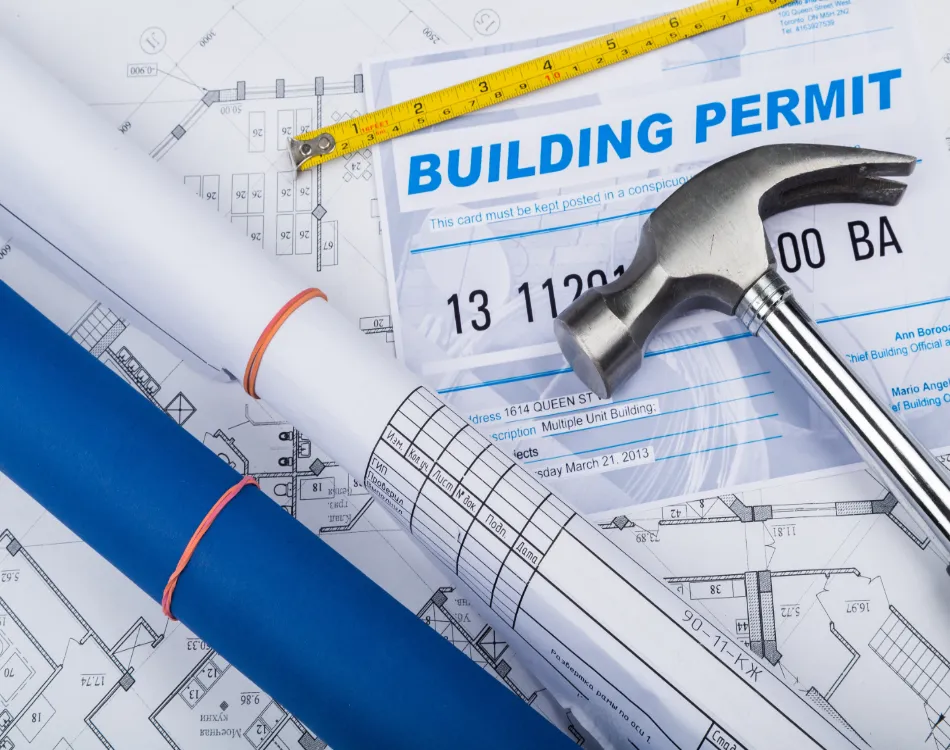
Once you have a plan in place for how to design a pool, you can start the process of applying for the proper construction permits. In most cases, you will need to submit a site plan to your local zoning board for approval before beginning any work. It is also important to check with your homeowners’ association (if applicable) to see if there are any restrictions on building pools in your community.
In Louisiana, you are required to submit a current survey and drawings of your swimming pool plan to the parish for approval. We are happy to handle this process for you as part of our pool design and construction service!
10. Know Your Pool Construction Timeline
Once your plans are approved, you can go from how to design a pool to the construction process. Depending on the size and complexity of the swimming pool, it can take anywhere from several weeks to several months to build.
Obviously, there are many factors that impact the construction timeline. This is why it’s important to consult with a professional pool contractor to understand exactly when you can expect to start using your new pool.
We know your time is valuable, which is why we pride ourselves on completing your swimming pool project faster than many other pool contractors. Miller Outdoors can complete a base pool design in 4 weeks, while a high-end pool design can be completed in as little as 8 weeks.
Miller Outdoors Can Bring Your Pool Design To Life
Congratulations! You’ve taken the first steps in how to design a pool you’ll love. Keep our top 10 tips in mind as you move forward with your project. Be sure to find a qualified contractor that you feel comfortable working with.
If you need help getting started, please don’t hesitate to reach out–we’d love to hear from you. Give us a call or fill out our contact form today!
See Also:
- Concrete vs. Wood vs. Pavers: Best Options for Pool Deck Construction in New Orleans
- Budget-Friendly Outdoor Living Space Ideas for New Orleans Homes
- What Does a Modular Outdoor Kitchen Cost in New Orleans?
- Transform Your Backyard into a Fun Outdoor Living Oasis
- Elevate Your Home’s Curb Appeal with Custom Luxury Landscaping in New Orleans

